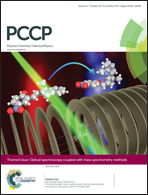Exploring the charged nature of supramolecular micelles based on p-sulfonatocalix[6]arene and dodecyltrimethylammonium bromide
Abstract
The aggregation of supramolecular amphiphiles formed from hexamethylated p-sulfonatocalix[6]arene (SC6HM) and dodecyltrimethylammonium bromide (C12TAB) was studied by capillary electrophoresis experiments and by kinetic probes. The hydrolysis of 4-methoxybenzenesulfonyl chloride (MBSC) was used to investigate the micropolarity of the micellar aggregates and their ability to solubilize and stabilize labile organic compounds against hydrolysis. Further insights were obtained using a more sophisticated kinetic probe: the basic hydrolysis of p-nitrophenylvalerate (NPV). This probe provides information on the ionic composition of the micellar interface and on the potential of the aggregates to be used as nanoreactors. The results obtained revealed that the charge of the micellar aggregates can be tuned from anionic to cationic through the adjustment of the C12TAB : SC6HM molar ratio and confirmed that these micelles have good solubilization properties. On the other hand, the kinetics of the p-nitrophenylvalerate basic hydrolysis suggest that, in the concentration range comprised between the first and second CMCs, Br− anions do not take part in the micellar structure.
![Graphical abstract: Exploring the charged nature of supramolecular micelles based on p-sulfonatocalix[6]arene and dodecyltrimethylammonium bromide](/en/Image/Get?imageInfo.ImageType=GA&imageInfo.ImageIdentifier.ManuscriptID=C5CP03718B&imageInfo.ImageIdentifier.Year=2015)

 Please wait while we load your content...
Please wait while we load your content...